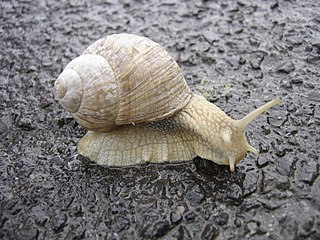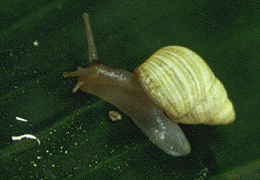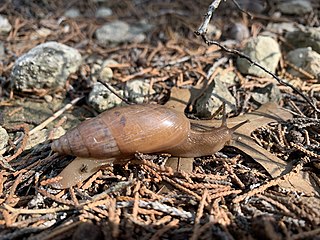
A snail is a shelled gastropod. The name is most often applied to land snails, terrestrial pulmonate gastropod molluscs. However, the common name snail is also used for most of the members of the molluscan class Gastropoda that have a coiled shell that is large enough for the animal to retract completely into. When the word "snail" is used in this most general sense, it includes not just land snails but also numerous species of sea snails and freshwater snails. Gastropods that naturally lack a shell, or have only an internal shell, are mostly called slugs, and land snails that have only a very small shell are often called semi-slugs.

The white-faced ibis is a wading bird in the ibis family, Threskiornithidae.

Pinus remota, commonly known as the Texas pinyon or papershell pinyon, is a pine in the pinyon pine group, native to southwestern Texas and northeastern Mexico. It can be distinguished from other pinyon species by its thin-walled seeds, which made it especially attractive as a food to Indians and Mexicans living where it grew. Spanish explorer Cabeza de Vaca noted that the papershell pinon was an important food for the Indians in 1536.

Achatinella is a tropical genus of colorful land snails in the monotypic Achatinellidae subfamily Achatinellinae.

Lissachatina fulica is a species of large land snail that belongs in the subfamily Achatininae of the family Achatinidae. It is also known as the Giant African land snail. It shares the common name "giant African snail" with other species of snails such as Achatina achatina and Archachatina marginata. This snail species has been considered a significant cause of pest issues around the world. It is a federally prohibited species in the USA, as it is illegal to sell or possess. Internationally, it is the most frequently occurring invasive species of snail.

Bermuda land snails, scientific name Poecilozonites, are an endemic genus of pulmonate land snail in the family Gastrodontidae. 12 species are known from the fossil record, and 4 of these species survived into modern times, but due to the highly negative effects of human development, the extant species has been reduced down to only bermudensis and circumfirmatus.

The Scotch bonnet is a medium-sized to large species of sea snail, a marine gastropod mollusk in the subfamily Cassinae, the helmet shells and bonnet shells. The common name "Scotch bonnet" alludes to the general outline and color pattern of the shell, which vaguely resemble a tam o' shanter, a traditional Scottish bonnet or cap. The shell is egg-shaped and fairly large, 2 to 4 inches in maximum dimension, with a regular pattern of yellow, orange or brown squarish spots. The surface sculpture of the shell is highly variable: the surface can be smooth and polished, have grooves, be granulated, or even be nodulose on the shoulder of the whorls.

Euglandina rosea, the rosy wolfsnail or cannibal snail, is a species of medium-sized to large predatory air-breathing land snail, a carnivorous terrestrial pulmonate gastropod mollusk in the family Spiraxidae.

Achatinella fuscobasis is a species of air-breathing land snail, a terrestrial pulmonate gastropod in the family Achatinellidae. This species is endemic to Hawaii.

Partula dentifera is an extinct species of air-breathing tropical land snail, a terrestrial pulmonate gastropod mollusk in the family Partulidae. This species was endemic to the Raiatea in the Society Islands of French Polynesia, where the last live individual was seen in 1972. It was officially declared extinct by the International Union for Conservation of Nature in June 2024.

Partula suturalis, commonly called the moorean viviparous tree snail or the sutural partula, is a species of air-breathing tropical land snail, a terrestrial pulmonate gastropod mollusk in the family Partulidae. This species was endemic to the island of Moorea, French Polynesia. It is now extinct in the wild. It was previously listed as extinct in the IUCN Red List of Threatened Species, but has been moved to extinct in the wild since 2009. This error was the result of changing taxonomy.

Euglandina is a genus of predatory medium- to large-sized, air-breathing, land snails, terrestrial pulmonate gastropod mollusks in the family Spiraxidae.

Partula is a genus of air-breathing tropical land snails, terrestrial pulmonate gastropod mollusks in the family Partulidae.

Euglandina singleyana, the striate glandina or striate wolfsnail, is a species of predatory air-breathing land snail, a terrestrial pulmonate gastropod mollusk in the family Spiraxidae.

Cinctura lilium, common name the banded tulip, is a species of sea snail, a marine gastropod mollusk in the family Fasciolariidae, the spindle snails, the tulip snails and their allies.

Macrostrombus costatus, formerly known as Strombus costatus and Lobatus costatus, or commonly known as the milk conch, is a species of large sea snail, a marine gastropod mollusk in the family Strombidae, the true conchs. They are an edible species and important food source for the inhabitants of where they are found. Conchs are most notable for their medium to large-sized ornamental shells. Milk conchs are dispersed among the tropical waters of the Atlantic Ocean, along the coasts and islands of North, Central, and South America.

Pittieria aurantiaca is a species of predatory air-breathing land snail, a terrestrial pulmonate gastropod mollusk in the family Spiraxidae.
Euglandina aurata is a species of large predatory air-breathing land snail, a terrestrial pulmonate gastropod mollusk in the family Spiraxidae.
Partula magistri was a species of air-breathing land snail, a terrestrial pulmonate gastropod mollusk in the family Partulidae.
















